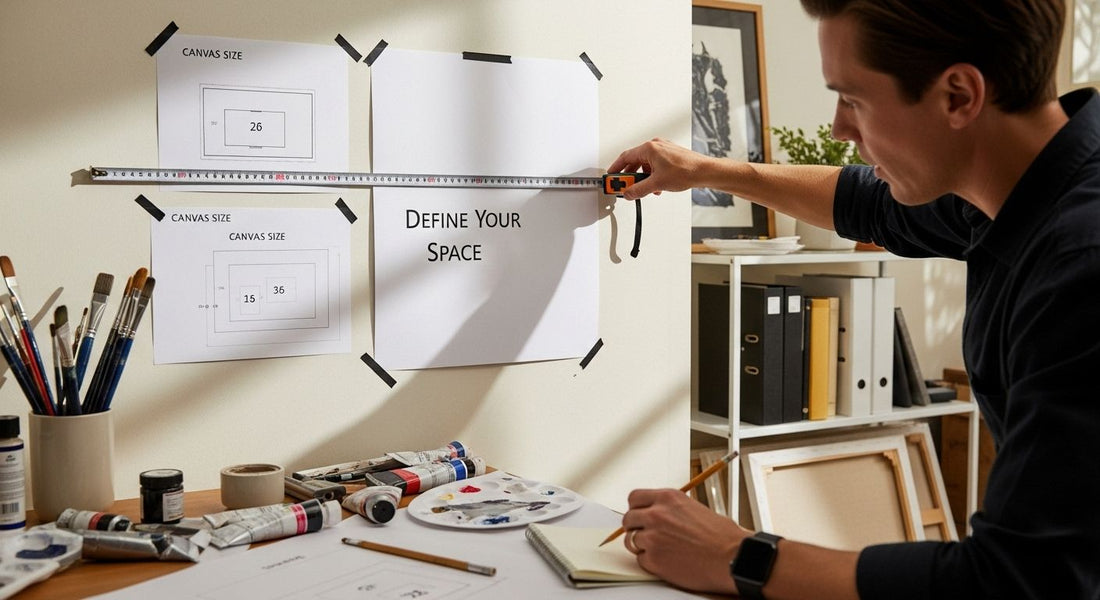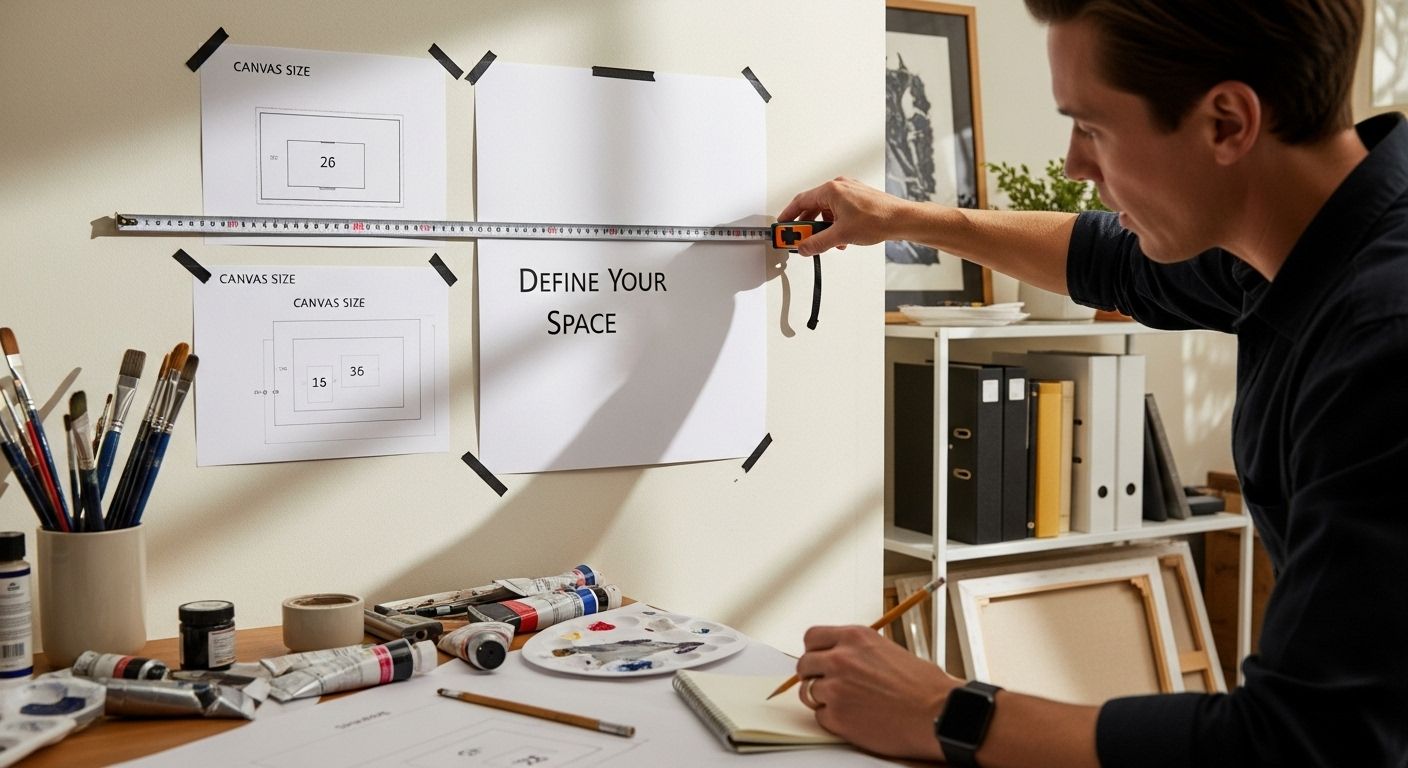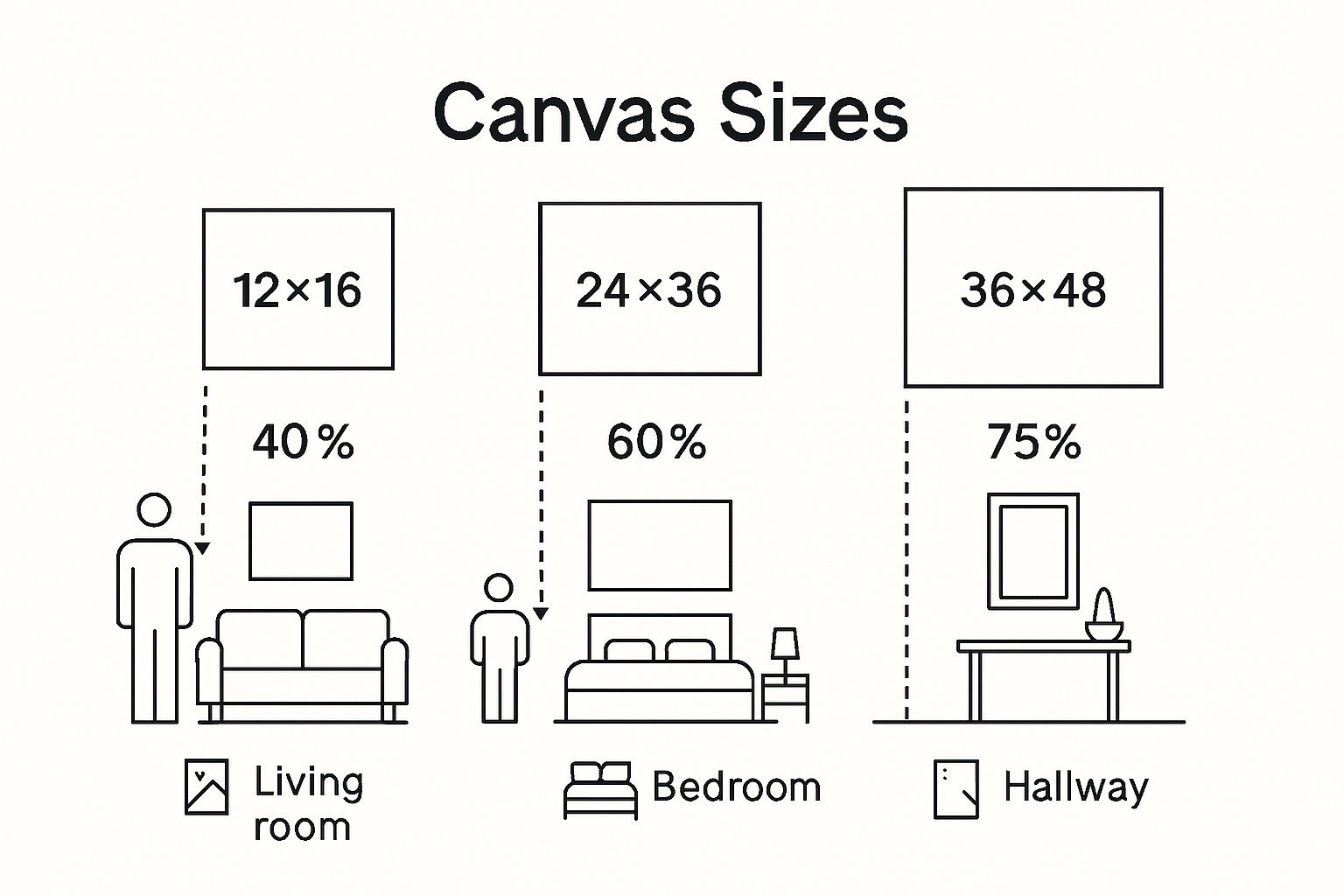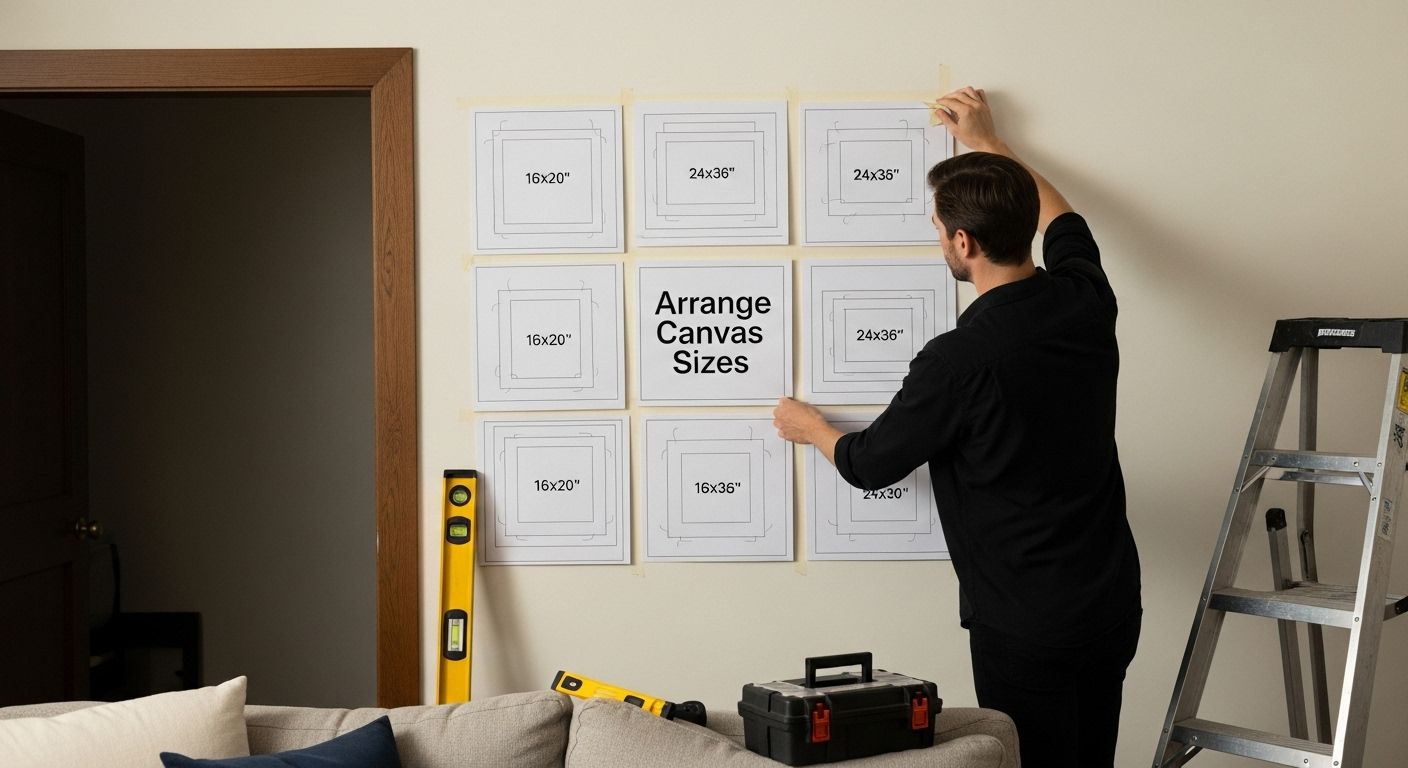
Discover the Best Canvas Sizes for Your Art Needs
Picking the right canvas size can completely change the way your room feels.

Some designers suggest your artwork should fill about 50 to 75 percent of your wall space for the best visual balance. Most people focus just on matching colors or finding the trendiest artwork. The real impact comes from knowing how size and placement shape the entire mood of your space.
Table of Contents
- Step 1: Define Your Space And Wall Dimensions
- Step 2: Select The Type Of Art You Want To Display
- Step 3: Determine The Impact Of Size On Visual Appeal
- Step 4: Choose Canvas Sizes Based On Your Preferences
- Step 5: Arrange Canvas Sizes For Optimal Display
Quick Summary
| Key Point | Explanation |
|---|---|
| 1. Measure Wall Space Accurately | Take precise measurements to ensure art fits well and looks visually appealing on your wall. |
| 2. Choose Art That Reflects Room’s Purpose | Select artwork that aligns with the emotional tone and function of each room in your home. |
| 3. Consider Canvas Size’s Visual Impact | Understand how different sizes affect room dynamics to enhance viewer engagement and mood. |
| 4. Follow Personal Preference in Art Selection | Choose canvas sizes and styles that resonate with your personal taste and storytelling needs. |
| 5. Arrange Art for Visual Balance | Optimal placement enhances the visual narrative; ensure pieces are at eye level and spaced thoughtfully. |
Step 1: Define Your Space and Wall Dimensions
Choosing the best canvas sizes begins with understanding your specific wall space and how artwork will integrate into your environment. Before selecting any canvas, you must accurately measure and evaluate your intended display area. This crucial first step ensures your art will look proportional, balanced, and visually compelling.
Measuring Your Wall Space
Start by gathering basic tools: a metal tape measure, pencil, and notepad. Stand back from your wall and visually assess the area where you plan to hang artwork. Carefully measure the width and height of the space, recording precise dimensions. Pay special attention to potential obstacles like light switches, window frames, furniture placement, or architectural features that might impact artwork positioning.
Professional interior designers recommend leaving approximately 6 to 12 inches of empty space around your canvas to create visual breathing room. This technique prevents artwork from feeling cramped or overwhelming your wall. When measuring, account for these surrounding margins to guarantee a balanced presentation.
Considering Room Proportions
Room scale dramatically influences canvas selection. Large, expansive walls benefit from oversized canvases or gallery-style multi-piece arrangements. Smaller rooms require more strategic sizing to avoid visual clutter. A general rule of thumb is selecting canvas sizes that occupy approximately 50 to 75 percent of your available wall space.
For standard living spaces, popular canvas dimensions include:
- 24" x 36" for medium-sized walls
- 36" x 48" for larger wall expanses
- 12" x 16" for compact areas or accent spaces
Remember that these recommendations are flexible. Your personal aesthetic, room layout, and artistic vision ultimately guide the perfect canvas selection. By meticulously measuring and understanding your space, you create a strong foundation for selecting artwork that transforms your environment.
Once you’ve completed your measurements, you’ll be prepared to explore canvas options that harmonize beautifully with your unique living space.
To help you get started with Step 1, here is a quick-reference table of tools and their purposes when measuring your wall space for canvas selection.
| Tool | Purpose |
|---|---|
| Metal tape measure | Obtain accurate wall dimensions |
| Pencil | Mark measurements and notes |
| Notepad | Record width, height, and observations |
| Painter’s tape | Mock up canvas sizes on the wall |
| Cardboard/paper | Create life-size templates for trial fit |
Step 2: Select the Type of Art You Want to Display
With your wall measurements complete, the next critical step involves selecting the art style that will transform your space. Your canvas choice should reflect not just aesthetic preferences, but also the emotional atmosphere and functional purpose of the room. Understanding art categories helps you make intentional selections that resonate with your personal narrative.
Understanding Art Genre Dynamics
Art genres dramatically influence room perception and emotional ambiance. Abstract pieces create visual intrigue and movement, perfect for contemporary spaces seeking dynamic energy. Landscape canvases introduce tranquility and natural depth, ideal for creating calm environments in home offices or relaxation areas. Portrait collections communicate personal connection, while urban or architectural prints bring sophisticated structure to minimalist interiors.
When exploring art types, consider how different styles interact with your existing decor. Modern interiors often benefit from geometric abstracts or monochromatic designs. Traditional spaces might welcome impressionist landscapes or classic figurative artwork. Explore art theme recommendations to refine your selection strategy and understand how different art genres complement specific room aesthetics.
Matching Art to Room Personality
Your art selection should tell a story. Living rooms might showcase bold, conversation-starting pieces that reflect personal journeys. Bedrooms demand softer, more introspective artwork promoting relaxation. Home offices require stimulating yet not overly distracting canvases that inspire productivity.
Key considerations for art selection include:
- Color palette compatibility with existing room decor
- Emotional response the artwork generates
- Scale and visual weight of the piece
- Personal connection or meaningful narrative
Remember that art is deeply personal. Trust your instincts and select pieces that spark joy, provoke thought, or simply make you smile. The most successful art choices are those that feel authentic to your individual style and create an environment where you feel genuinely comfortable and inspired.
Step 3: Determine the Impact of Size on Visual Appeal
Canvas size transcends mere measurements. It represents a powerful visual language that communicates mood, energy, and artistic intention. Understanding how different canvas dimensions interact with your space can transform a simple wall decoration into a compelling narrative that captivates and inspires.
Proportional Visual Storytelling
Large canvases command attention and create dramatic statements. A 48" x 72" piece becomes an architectural element, defining room character and drawing the eye across expansive walls. These oversized artworks work brilliantly in open living areas, conference rooms, or spaces with high ceilings. They communicate confidence and provide a bold visual anchor that elevates the entire room’s aesthetic.
Conversely, smaller canvases between 12" x 16" and 24" x 36" offer nuanced storytelling. These more intimate sizes work wonderfully in personal spaces like home offices, bedrooms, or hallways. They invite closer examination, creating moments of quiet reflection and personal connection. Smaller canvases allow for gallery-style arrangements, where multiple pieces interact to create a rich, layered visual experience.
Strategic Size Selection
Effective canvas sizing requires understanding visual weight and room dynamics. According to research examining aesthetic experiences, artwork size significantly influences viewer perception and emotional engagement. Recommended sizing strategies include:
- Large walls (8+ feet wide): Consider 36" x 48" to 48" x 72" canvases
- Medium walls (4-8 feet wide): Select 24" x 36" to 30" x 40" pieces
- Small walls or accent spaces: Choose 12" x 16" to 18" x 24" canvases
Remember that negative space matters as much as the artwork itself. A well-chosen canvas should breathe within its environment, creating visual balance without overwhelming the room. Pay attention to furniture placement, architectural features, and overall room composition when making your final selection.

Ultimately, canvas size is a personal journey of visual storytelling. Trust your aesthetic instincts and select pieces that resonate with your emotional landscape, transforming simple wall space into a profound artistic statement.
Step 4: Choose Canvas Sizes Based on Your Preferences
Personal preference is the heart of art selection. Beyond technical considerations, your emotional connection to a piece determines its true value. Canvas sizes should not just fit your wall but also reflect your unique aesthetic sensibility and personal storytelling.
Exploring Personal Artistic Expression
Your canvas selection is a deeply intimate process that goes beyond standard measurements. Some individuals prefer bold, statement pieces that dominate a room, while others appreciate subtle, intricate artworks that invite closer examination. According to research examining aesthetic experiences, canvas size profoundly impacts how we perceive and interact with art.
Consider your personality and lifestyle when choosing canvas dimensions. Are you drawn to minimalist designs that create breathing room? Or do you love complex, layered compositions that spark conversation? Discover canvas print strategies that align with your individual style and home environment.
Practical Preference Mapping
To systematically explore your preferences, create a visual mood board. Collect images of artworks in various sizes, then physically mock up potential arrangements using painter’s tape or paper cutouts. This technique allows you to experiment without commitment, helping you visualize how different canvas sizes interact with your space.
Consider these preference exploration strategies:
- Photograph your wall and digitally overlay potential canvas sizes
- Use cardboard or kraft paper to create life-sized templates
- Arrange smaller canvases in gallery-style configurations
- Compare how different sizes complement your existing furniture
Remember that art is subjective. While design principles offer guidance, the most important criterion is how the artwork makes you feel. A canvas that resonates with your personal narrative will always look perfect, regardless of standard sizing recommendations.
Trust your instincts. Your home is a canvas, and each artwork you select adds a brushstroke to your unique visual autobiography.
Step 5: Arrange Canva Sizes for Optimal Display
Arranging canvas art transforms a simple wall into a captivating visual narrative. The strategic placement of artwork can elevate your space from ordinary to extraordinary, creating emotional depth and visual intrigue that reflects your personal aesthetic journey.
Strategic Placement Principles
Successful canvas arrangement begins with understanding visual balance. The center of your artwork should typically align with eye level, which is approximately 57 to 60 inches from the floor. This universal design principle ensures comfortable viewing and creates a harmonious visual flow. Professional designers recommend treating your wall as a compositional canvas, where each piece contributes to an overarching visual story.
For gallery-style arrangements, consider creating a unified visual weight. Mix canvas sizes thoughtfully, allowing smaller pieces to complement larger focal points. Create memorable wall displays by establishing a central anchor piece and building complementary compositions around it. According to The Art League’s display guidelines, experimenting with layouts and allowing time for reassessment is crucial to achieving a sophisticated arrangement.
Practical Arrangement Techniques
Before permanently mounting canvases, develop a strategic approach. Use painter’s tape to create paper templates representing each canvas, allowing you to experiment with configurations without damaging walls. This technique enables you to visualize spacing, alignment, and overall compositional balance.
Consider these arrangement strategies:
- Maintain 2-3 inches of consistent spacing between canvases
- Create visual symmetry or intentional asymmetry
- Balance color intensity and visual weight across the arrangement
- Consider how natural and artificial light interact with your canvases
Remember that art arrangement is both technical and intuitive. Trust your aesthetic instincts while respecting fundamental design principles. Your wall should tell a story that resonates with your personal style, inviting viewers to pause and explore the visual landscape you’ve curated.

Find Your Perfect Canvas Fit and Elevate Your Space
Struggling with choosing the right canvas size for your walls? You are not alone. Many art lovers feel uncertain about measurements, how art fits into their space, and how to select visually balanced arrangements. This article outlines the step-by-step process, but what you need next is the confidence to take action and bring your vision to life. Marta Ellie offers handpicked collections and size options to match every wall and every style, from oversized statement pieces for large spaces to thoughtful arrangements for intimate rooms. Let our exclusive art collections help you transform confusion into clarity and empty walls into masterpieces.

Why wait to create the home you have always imagined? Visit Marta Ellie’s website now to explore detailed product listings, browse by collection, or find inspiration for memory walls like the Family Reunion Memory Wall Art. Shop today and see how the right canvas size truly completes your space.
Frequently Asked Questions
What canvas size should I choose for my wall?
The ideal canvas size depends on your wall dimensions and overall room aesthetics. As a guideline, canvas sizes should occupy approximately 50 to 75 percent of your available wall space for a balanced look.
How do I measure my wall space for artwork?
To measure your wall space, use a metal tape measure to obtain the width and height of the area where you plan to hang your artwork. Remember to leave about 6 to 12 inches of empty space around the canvas for visual breathing room.
What types of art styles work well with different canvas sizes?
Larger canvases (36" x 48" or larger) make dramatic statements in spacious areas, while smaller canvases (12" x 16" to 24" x 36") provide intimate storytelling suitable for personal spaces. Choose art styles that complement your room’s personality to enhance its atmosphere.
How can I arrange multiple canvases on a wall?
For optimal display, consider using painter’s tape to outline the arrangement of canvases before mounting them. Maintain 2-3 inches of consistent spacing between pieces, and aim for visual balance by mixing larger and smaller canvases to create a cohesive gallery-style look.
Recommended
- Canvas vs Framed Prints: Choosing the Right Art for 2025 – Exclusive Canvas Art
- Art Print vs Canvas: Best Choice for Modern Home Decor 2025 – Exclusive Canvas Art
- Preserving Canvas Artwork: Best Tips for Art Lovers 2025 – Exclusive Canvas Art
- Sizing Canvas Prints: Artful Choices for Walls in 2025 – Exclusive Canvas Art